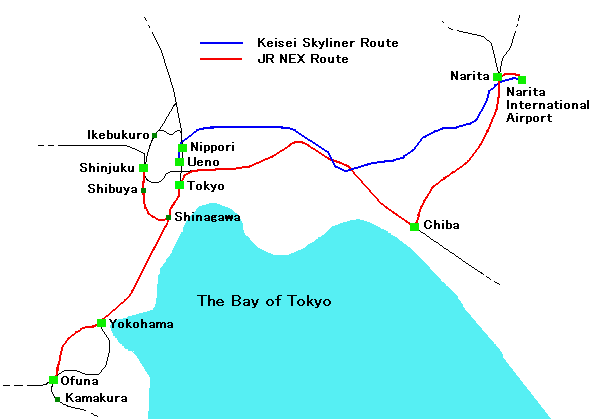

About Kesei:
First, let's take a look at the Keisei-trains. Keisei is a private
railway with 1435 mm-gauge starting at Keisei-Ueno (a small walk from
JR's Ueno station) and then running to Narita and Narita Airport, a
branch line goes to Chiba. Keisei offers the cheapest way to get to
the airport with their tokkyu- (limited express) trains. They cost
just the basic fare of 980 Yen from Keisei-Ueno, take between 73 and
80 minutes and run every 20 minutes all over the day. Normal cars are
put on the service of these trains, and they are not very comfortable,
there is also no seat reservation available. So if you want more
comfort, take the Skyliner. These very fast express trains only stop
at Nippori (two stations out from Keisei-Ueno with very good
possiblities to change to JR) and take just 61 minutes to the Airport.
Besides the basic fare of 980 Yen there is a supplement of 900 Yen,
including the mandatory seat reservation. The Skyliner runs every 30
minutes in the morning and every 40 minutes during the rest of the
day, making 23 return journeys between Keisei-Ueno and Narita Airport.
All Skyliners are 8-car- trains of the AE-100 series. There are also
trains to Higashi-Narita, approximately every 20 minutes. But these
trains are either locals or the rather slow kyuko- (express) trains,
some going through to Ueno, some only to Narita.
About JR Narita Express:
Since JR started its service to Narita Airport in 1990, this service
with the Narita-Express (NEX) has attracted many, many passengers.
Just like the Skyliner, the NEX also makes 23 return journeys a day
between Tokyo station and Narita Airport, taking between 53 and 64
minutes. Trains run every 30 minutes, expect in the morning between 9
and 12, when there is only one train per hour. The NEX does not only
go from Tokyo to Narita Airport, but normally starts in Shinjuku and
Yokohama. Both train parts then meet and are coupled at Tokyo station.
The first NEX-trains (253 series) were 6-car-trains made from two
3-car-sections. Today, the NEX runs with 9- or 12-car-trains, thus
having one or two 6-car-sections and one 3-car-section. The coupling
in Tokyo station works as follows: First cars no. 7 to 12 arrive from
Yokohama with car 12 being the first car towards Narita Airport. Four
minutes later the second train arrives from Shinjuku with cars no. 1
to 6. This train stops a few meters before the other train, and then
goes on slowly to be coupled. The doors on the front-end of the cars
open automatically, and then a concertina gangway connects both
trains, so that passengers can move freely between the two parts. Of
the 23 trains per day, there are 6 trains direct from Shinjuku - Tokyo
- Narita Airport, 5 trains direct Yokohama - Tokyo - Narita Airport
and 12 trains join at Tokyo, from Shinjuku as well as from Yokohama.
There are actually 4 trains daily coming from Ikebukuro via Shinjuku,
and 2 trains coming from Ofuna via Yokohama. Many trains also stop at
Shinagawa, and some in the evening also stop at Chiba and Narita. The
NEX is more expensive than the Skyliner, costing 2890 Yen from Tokyo
in the normal car and 4890 Yen in the Green Car (1st class). The
prices from the other stations (Ikebukuro, Shinkuju, Shinagawa, Ofuna
and Yokohama) are of course higher. The price includes the seat-
reservation, but when all seats are taken, standing room is available
- for the same price. JR also offers a rapid train service, which is
much cheaper (1260 Yen): Trains on the Sobu- rapid/Yokosuka-line make
14 return journeys to Narita Airport daily, taking 85 minutes to get
there from Tokyo.
So which train is the best? The Narita-Express is very
comfortable
(especially the Green Car), and as it goes through to Shinjuku and
Yokohama, it is also very convenient for those who want to change at
these stations. But changing at Tokyo is not very good, as the trains
stop at the underground platforms of the Yokosuka-line, far away from
the other JR trains and very far away from the Shinkansen platforms.
Keisei is quite cheap, which is their big advantage. They cannot offer
as many good possiblities to change to other trains, but if you take
Keisei, then you can change to JR at Nippori. There you do not have to
walk very much; as the Skyliner takes only 56 minutes to Nippori, it
is faster to change to JR there and then go to Ueno or other places
than to take the NEX and to change at Tokyo. Skyliner and NEX are both
very nice trains, although the NEX looks more interesting from outside
and also from the inside with black-red seats (a French design), while
the Skyliner has rather traditional brown seats. Both trains have
vending machines and telephones. JR and Keisei both have a share of
about 12 percent of the traffic to and from the airport. This share
has risen significantly since 1990, and most of that increase was due
to the decrease of the Limousine Bus service. There are many bus
routes from central Tokyo to the airport, which take at least one hour
and cost 2700 Yen; buses on most routes run every 10 minutes. Actually
JR has won very many passengers, while Keisei's Skyliner has lost
about 20 percent since 1990. The future might bring Keisei more
passengers again, as they are planning a through service from their
line into the Asakusa-subway into the heart of Tokyo and further onto
the Keihin-Kyuko-line. So a direct rail link between Narita Airport
and Haneda Airport could be made.